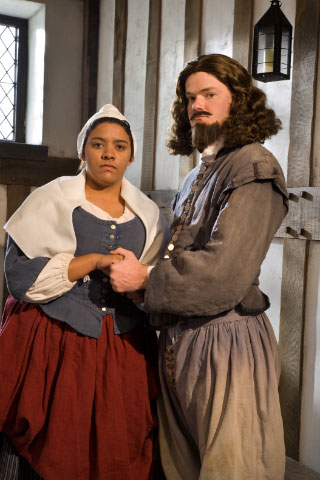Elizabeth Key (Kaye) 1630 — ?

In 1655, a mulatto (bi-racial) woman named Elizabeth Key (or Kaye) sued for her freedom and that of her son, John. Early generations of Africans and their descendants in Virginia had access to the courts to redress their complaints, before legislators restricted their use of the legal system. Was it possible for a mulatto woman to sue and win her freedom in seventeenth-century British North America?
Elizabeth Key's suit for freedom rested on several factors. First, she was the daughter of Thomas Key, an English planter and member of the Virginia House of Burgesses, and an enslaved woman. English common law dictated that a child inherited the status of its father. Second, Elizabeth’s father had arranged an indenture under which she would be freed at the age of fifteen, but that contract had been violated. Finally, Elizabeth had been baptized in the Church of England and was a practicing Christian.
William Greensted (or Grinsted), an English attorney, represented Elizabeth in the courtroom. Witnesses testified to support Elizabeth’s case and her parentage. One decision allowed Elizabeth her freedom on account of her father’s freedom, but another denied her liberty because of her mother’s enslaved status. Eventually, the case rose to the Virginia General Assembly, which appointed a committee for its review.
The Virginia General Assembly resolved “that by the Common Law the Child of a Woman slave begot by a freeman ought to be free.” They considered the value of her Christian faith and determined that her indenture demanded that she be treated “more Respectfully than a Common servant or slave.” The General Assembly decided that “the said Elizabeth ought to be free and that her last Master should give her Corn and Clothes and give her satisfaction for the time she hath served longer than She ought to have done.” After determining the freedom of Elizabeth and her son, the General Assembly returned the case to the lower courts, where they freed Elizabeth.
Prior to the court cases, Elizabeth Kay and William Greensted had a personal relationship and bore a son, John. They were legally married in July 1656 after the court freed Elizabeth and John, and William completed his own indenture. Future mixed-race couples were forbidden marriage after 1691, when Virginia laws prohibited the practice. Centuries passed before the United States Supreme Court ruled that the prohibition of interracial marriage was unconstitutional in the Loving v. Virginia court case in 1967/68.
After Elizabeth Key’s successful petition for her freedom, legal and social conditions for free blacks and enslaved people began to decline. By 1662, Virginia legislators resolved that the condition of the mother determined the status of the child—opposite the practices of English common law—effectively making slavery a hereditary status. Another consequence of the law was that white fathers were not legally required to manumit or support their bi-racial offspring. Baptism no longer was a determining factor for manumission after 1668, when the Virginia legislature decided that Christian faith did not exempt a person from bondage. Elizabeth and William’s children faced a different world than their parents, as the British slave trade increased to North America, helping to make Virginia a slave society by the early eighteenth century.







